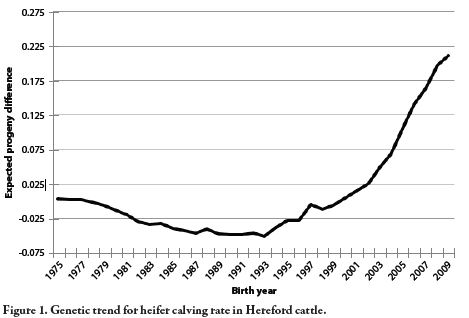



Heifer Calving Rate is Lowly Heritable in Hereford Cattle
Calving rate is not hugely heritable in Hereford cattle but genetic improvements are still possible, conclude Kansas experts.Reproductive failure is consistently a top reason for culling beef cows from the herd, writes a team of researchers at Kansas State Univeristy.
H.L. Bradford, D.W. Moser, J.M. Bormann, and R.L. Weaber of KSU write that culling young females is very costly to commercial producers because a young female hasn’t generated enough income to pay for the cost of developing that female. One way to improve reproductive performance in the cowherd is through genetics. Although reproductive traits tend to be lowly heritable, genetic improvement can be made through selection.
Beef producers traditionally have selected for increased scrotal circumference to improve female fertility.
Scrotal circumference is an indicator trait and is positively correlated to female reproductive performance. Faster genetic improvement could be made by selecting for an easy-to-measure, economically relevant trait.
The American Hereford Association’s whole-herd reporting program has enabled the collection of more difficult-to-measure phenotypes such as reproductive performance. Producers enrolled in the program must report the reproductive status of all breeding-age females on a yearly basis.
Graph courtesy of Kansas State University
This reporting system includes information such as if a female was exposed for breeding and if she calved the following year. Traits like heifer calving rate and the likelihood that daughters will calve as a heifer if they were retained as replacements can be developed based on the data reported by Hereford breeders. Our objective was to estimate the heritability of heifer calving rate, an economically relevant trait.
Experimental Procedures Calving records on females born from 2000 through 2009 were obtained from the American Hereford Association. After editing, 98,844 calving records and a six-generation pedigree with 289,141 animals remained for the analysis. Data were analyzed with a multiple-trait logistic animal model with a random effect for additive genetics and fixed effects for contemporary group and age at calving.
Contemporary group was defined as the combination of herd, yearling weigh date, and yearling group. There were 4,745 contemporary groups represented in the heifer calving records. Contemporary groups with either all females calving or no females calving were not included in the data because there were no phenotypic differences among the heifers in those groups.
Results and Discussion
The heritability estimate for heifer calving rate was 0.15 ± 0.01. Like most reproductive traits, this trait was lowly heritable. Yet, the reproductive success of heifers is relatively easy to measure through the American Hereford Association’s whole-herd reporting system, making heifer calving rate a practical trait for selection. Genetic selection for heifer calving rate can increase the likelihood that a sire’s daughters will calve as heifers.
The genetic trend for heifer calving rate is presented in Figure 1. In the past decade, genetic improvement has occurred in the likelihood that daughters will calve as heifers.
Implications
Heifer calving rate was lowly heritable, but producers can still select for heifer calving rate to make genetic improvement.



